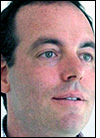Sep 11, 2006Real-time location systems (RTLS) provider Parco Wireless has announced a line of tracking hardware and software based on ultra-wideband (UWB) technology. Newly designed from the ground up, this technology utilizes silicon-based active RFID tags and interrogators (readers), and supports for off-the-shelf power-over-Ethernet switches. The company says it has contracts to deploy its system at more than 75 long-term-care facilities in the New York City area.
The suite of products, called Précis, includes asset tags, patient wristbands and personnel bands—all with embedded active tags operating at the 6.5 GHz frequency band—and two designs of RFID readers. The suite is designed for use within hospitals, nursing homes and other health-care facilities to track assets and patients.
Parco has been offering an RTLS suite based on UWB technology for several years. In mid-2004, the company sold its first commercial installation to the Washington Hospital Center in Washington, D.C. (see Hospital Gets Ultra-Wideband RFID).
Early UWB systems were developed mainly as military surveillance tools because they could "see through" trees and beneath ground surfaces. The Federal Communications Commission (FCC) approved UWB for commercial sale in February 2002, and by the summer of 2003, commercial products were getting FCC certification, according to Parco's founder and CEO, Scott Cohen. Today, there are numerous UWB devices and applications, including those for ground-penetrating radar and medical imaging; vehicular collision-avoidance systems; and communications and measurements.
UWB devices emit a series of extremely short pulses (billionths of a second or shorter) simultaneously across a wide band of frequencies. In its most recent UWB Report and Order, the FCC defined UWB as an RF transmission with a bandwidth that exceeds either 500 MHz or 20 percent of a specific frequency band, between 3.1 GHz and 10.6 GHz. In contrast, conventional UHF RFID interrogators and tags in the United States operate between 902 and 928 MHz and can transmit a signal with a bandwidth of no more than 500 kHz. (In Europe, UHF RFID devices operate between 865.6 and 867.6 MHz, and can transmit signals with a maximum of 200 kHz.)
Parco's new suite is built using Time Domain Corp.'s Pulson UWB technology, a silicon-based infrastructure that Cohen says will allow for greater volume production and lower tag costs. That means all the components and circuitry of the tag are created on one or more silicon chips. "We are very bullish on the growth of RFID," Cohen says. "We decided to go with a firm that has experience in silicon-based, ultra-wideband technology. Silicon is the holy grail for RFID for us because with silicon, we can more easily get into mass production at a much lower threshold and price per radio, which we can pass onto the customer."
The tag antenna used in Parco's suite has also been changed, Cohen says. The older design incorporated what Cohen called a peg antenna, a small brass antenna post sitting perpendicular on a ground plane, which made the tag's height 1 inch. But customers prefer smaller tags that are less obtrusive and lighter in weight, so Précis uses a so-called patch antenna that allows for tags a half inch in height.
The new Précis readers can be mounted on ceilings, and each tag can be read at a maximum range of 300 feet if used in an open area, or about 60 feet if read through four standard (drywall) walls. Once per second, the tags transmit a signal consisting of a unique ID number, and readers within the read range compute the tag's radius. That device then passes the data to the Parco RTLS Manager, which utilizes the radius information from at least three readers and algorithms to compute the tag's location. The location is then sent via middleware to a database that can be accessed by third-party software. The software can be integrated with the Précis suite via Parco's Software Developer's Kit (SDK), which contains application programming interfaces (APIs) enabling the sharing of data among Parco's products and the third-party application.
Already, Précis is netting new business opportunities for Parco. Late last month, Parco announced a $4 million deal with Sysgen Data, a maker of RFID tracking software. Sysgen's Web-based tracking software is designed to help nursing homes track the exact location and status of caregivers, high-value assets and patients suffering from dementia and Alzheimer's. The two companies will develop and deploy a tracking system that includes Précis, integrated with Sysgen's software, at more than 75 long-term care facilities in the New York City tristate area. Cohen declined to comment as to which facilities were included, citing confidentiality agreements.


